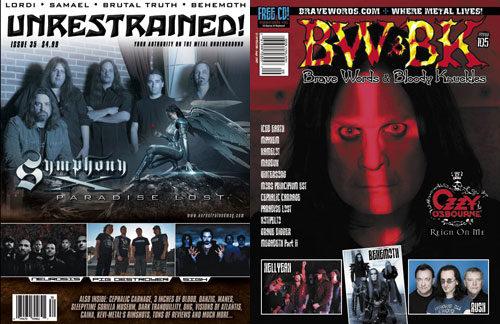Metal on Metal
How metal magazines—and their fans—keep the Canadian music magazine industry afloat
 On the right night, at the right bar, metal fans show up ready to go. Young men and women, barely old enough to cross the ID line, scan merchandise, buy drinks and wait for the show. At the end of a good night, they’ll stagger, — if not limp — toward the exit doors, disoriented, intoxicated or both, their T-shirt collars hanging to their diaphragms, heavy with sweat.
On the right night, at the right bar, metal fans show up ready to go. Young men and women, barely old enough to cross the ID line, scan merchandise, buy drinks and wait for the show. At the end of a good night, they’ll stagger, — if not limp — toward the exit doors, disoriented, intoxicated or both, their T-shirt collars hanging to their diaphragms, heavy with sweat.
The state of Canadian music journalism is rarely anyone’s first thought when seeing fans of Killswitch Engage spitting blood and dust into bandanas after bearing the impact of one too many crowd surfers at the Vans Warped Tour. Or when hearing about how at one point during Behemoth’s stop at Toronto’s Opera House, the only way to leave the seething mosh pit was to climb the bar.
Few would imagine that many of these fans, as avid readers of Unrestrained! and Brave Words and Bloody Knuckles, help to keep music journalism alive in Canada. They’re regular readers of the nation’s primary hard rock and metal titles.
There is no shortage of free or online music publications in Canada, yet paid circulation magazines have trouble surviving. There are only two popular music publications that have substantial newsstand and subscriber presence. The 15-year-old Chart is the longest-running consumer title, while trade publicationCanadian Musician has been around since 1979, and both usually cover mainstream and alternative Canadian rock.
After the leading pair, Unrestrained! and BW&BK are the two longest-running paid-circulation music magazines, specifically targeting a genre of music that receives little support from other media outlets. Both were started by veterans of M.E.A.T., one of Canada’s original hard rock magazines. “Metal” Tim Henderson, CEO and president of BW&BK, co-founded his magazine 13 years ago. Its current frequency is 10 issues per year, and its circulation hovers around 25,000 to 30,000, with 25 per cent sold in Canada. “I’m pretty proud of the fact that we’ve been able to survive this long, especially flogging heavy metal,” says Henderson. “We’re not selling out, and I’m not trying to diss Chart ’cause they’re doing their own thing, but we don’t have to put Sloan or Coldplay on the cover to keep going. No. We’ve put heavy metal and we will always put heavy metal. End of story.”
The smaller of the two publications, Unrestrained!, began in 1997. It is published quarterly and has a circulation of 15,000 copies, with 30 to 40 per cent distributed in Canada. Co-founder and coordinator Adrian “The Energizer” Bromley is, like Henderson, proud of his magazine’s decade of existence, particularly whenUnrestrained! eschews covering more commercial heavy bands in favour of featuring diverse underground and “extreme” music. “I put 10 years of my life into this magazine,” Bromley says. “There’s no way I’m going to blow our whole identity on one failed attempt at an issue that’s trying to make big bucks.”
According to Jeffrey Noonan, an associate professor of music at Southeast Missouri State University, music magazines have historically tended to be commercial productions. However, music titles may also be what Noonan characterizes as fan magazines, publications created by fans for fans that instead promote a lifestyle, genre or particular understanding of music. “Magazines founded by real fans tend to have a hard time surviving, because they try and stay pure,” Noonan says. “They try and focus on the music, on the personalities, whatever, and try not to get sucked into the commercial end of things.”
Henderson is wary of classifying BW&BK as a fan magazine. Although Noonan uses the term to describe any publication created by fans for fans, it runs the risk of connoting a lack of quality, perspective and professionalism — suggesting the kind of magazine that runs bedroom pin-ups of pop stars that target guileless 12-year-old readers. “Gene Simmons told me a very wise thing once — that fanzines are really just baby magazines,” Henderson says. “Everyone has to start somewhere and we’ve been doing this almost 15 years, so for somebody to call Brave Words just a fanzine — hey, certainly at the end of the day, we are fans, and maybe that’s the beauty of it right there.”
When looking at the content of both magazines — mostly artist features, interviews, reviews, and band and industry news — there is no doubt that BW&BK and Unrestrained! are written, in the words of Jeffrey Jensen Arnett, author of Metalheads: Heavy Metal Music and Adolescent Alienation, “by metalheads for metalheads.”
“The people who’re reading [these magazines] aren’t looking for The Economist or The New York Review of Books,” says Arnett. “They’re looking for more of what you might call advocacy journalism. They’re looking for people who are on their side.”
The communal aspect of the genre is crucial to metal culture. Its entire structure depends on an interwoven network of fans, musicians, promoters, record companies and media. The closeness inherent in the metal scene is, in part, born of the reputation it has garnered. Henderson has seen the way negative perceptions of metal and its fan base have influenced his dealings with advertisers. “Sadly, the outside view is that it’s gutter music for a bunch of bums and hippies and drug users,” he says. “Just a bunch of kids that have no disposable income.”
The reputation of metal fans, rightly or wrongly, might precede them, but they are certainly loyal. Josh Hogan, founder of Diminished Fifth records, an east coast metal label, notes that metal is one of the few genres left whose fans still purchase CDs. Independent record company operators know this and target their advertising to readers of Unrestrained! and BW&BK accordingly. But this suggested presence of buying power has not translated into much interest from other kinds of advertisers. National advertisers already sell into international magazines read by Canadians, and don’t necessarily need homegrown music publications.
Henderson did recently convince Jägermeister to buy in, but generally he says the “suit and tie guys” at agencies aren’t sold on metal magazines as the right demographic for their products. “It’s kind of ridiculous that we can’t get advertising outside the music industry,” he says. “I go to shows and see people holding a bottle of Molson Canadian and they’ve got their Doc Martens on.”
While securing advertising remains a challenge, both magazines rely on their bond with metal fans — and to some extent, rock fans in general — to keep going. Unrestrained! has refined its editorial focus by covering bands rarely recognized in international competitors’ magazines. BW&BK devotes attention to its online component, which features a regularly updated metal newswire, as well as the Braveboard, an electronic message board used by fans and industry personnel to talk music and promote new artists, album releases and shows.
One Braveboard user is 20-year-old metal fan Gregory Darwin. He recognizes the close-knit nature of the metal community, and sees its downside. Speaking specifically about Toronto’s metal scene, he says, “It becomes impossible to criticize a band without someone taking offence.”
This mentality may extend beyond the scene to the publications covering it, as both BW&BK andUnrestrained! are interested in preserving and supporting metal culture. Some niche magazines may face questions about the level of their critical analysis, but both Bromley and Henderson say their magazines are as objective as any others in the business. “Objectivity is part of everything in life,” Bromley says. “In terms of music and music magazines and journalism, I’m sure there’s certain elements where it doesn’t come out as much as it should in certain situations, but we know what’s shit and what’s awesome.”
Darwin, who also reads both metal magazines occasionally, has no complaints about the writing. “It’s very informal and casual,” he says, “but isn’t glaringly terrible.” Contributors to both magazines may not be the most polished, Bromley agrees, but he believes they do have their own voices. “I’m not saying that I’m the greatest writer,” he says, “but I’ve got a style and an identity.”
Canadian music magazines in general may be at a disadvantage when compared to the international competition because they publish in a smaller market and have less access to celebrities to use as billboards for their covers. However, targeted niche magazines such as BW&BK and Unrestrained! might actually benefit from having less mainstream competition. They stick to exactly what they know and rely on their one precious commodity — devoted fans — who likely will stick around as long as there are shows to see, limbs to bruise and reasons to believe.
To listen to Killswitch Engage click here
To hear Behemoth click here
Related Posts
Ashley Petkovski was the Director of Communications for the Spring 2008 issue of the Ryerson Review of Journalism.










































Pingback: Metal on Metal: How metal magazines – and their fans – keep the Canadian music magazine industry afloat – Ryerson Review of Journalism | ashley writes…